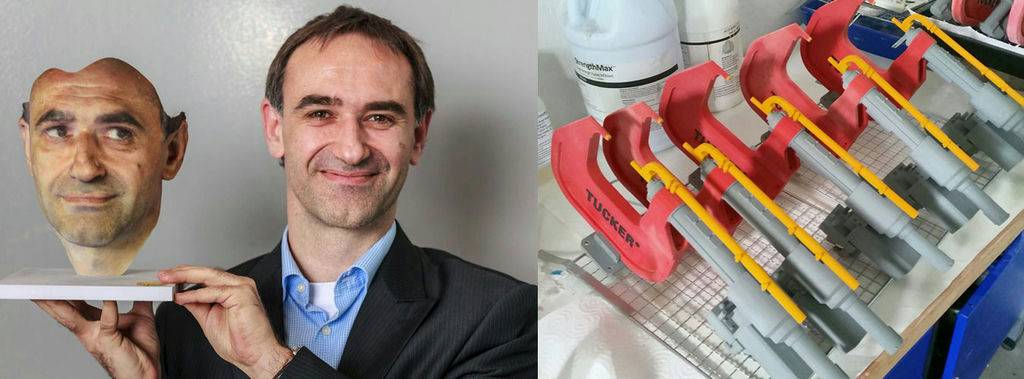
[vc_row][vc_column][vc_column_text]3D Fab from Radolfzell (at the Bodensee) offers additive manufacturing for everyone. In this interview, their manager Dr. Mario Hüttenhofer explains how 3D print proves itself in development, prototype construction, and as a visualization method; why a broader range of materials would be desirable, and why his firm is working with the Additive Manufacturing Association within VDMA.
Could you provide our readers with a short introduction to 3D Fab?
Dr. Mario Hüttenhofer: With pleasure. As contract manufacturers, we aim at offering additive manufacturing to everyone. This covers all sectors, from major corporations and schools to engineering and architecture offices to sole inventors. While we are two colleagues, we can draw on temporary personnel in peak times, and we cooperate with other manufacturing services providers to be able to offer our customers the whole range of AM technologies available today from one source.
Which part of the additive manufacturing value chain do you cover?
Hüttenhofer: First and foremost, we are a manufacturing services provider. For our customers, we exploit the technologies to the fullest. We cover a broad part of the value chain with our possibilities in 3D scanning and additive manufacturing: development, small batch series, series. Our range here includes prototypes, built-in parts, housings, and tools, up to customer-specific equipment – for example individual mounting brackets, inlays and insertsfor optimal handling of products in manufacturing processes. One of our strengths is the production of multi-color models for presentations, fairs, or as a sales support. The story of 3D Fab began in 2012 with the production of such multi-colored models.
Which materials and technologies do you offer?
Hüttenhofer: We offer three technologies. One of them is the name-giver of “3D print”, meaning the three-dimensional full-color print with a polymer-gypsum mixture that allows for the realization of high-resolution prints in 390,000 colors. In addition, we offer our customers the polyjet technology with which we manufacture mostly master forms for molds but also presentation models, due to its high surface quality. For fast, simple, and low-priced first drafts, we have FDM printers which build up components in strands out of plastic filaments. As mentioned before, we offer other technologies, such as laser sintering or stereolithography via our manufacturing network with partners from our region. These can also realize larger plastic and metal components.
In your experience, which arguments convince customers to use AM?
Hüttenhofer: In development and production, customers decide for AM because it works without tool construction: on the one hand, this reduces time and costs, on the other hand it offers more flexibility. This is because prototypes and components are easily modifiable. In presentations, customers like how single constructions as well as whole systems can be represented, multi-colored and true to scale. This could be a highly complex turbine or a gas production installation which consists of many individual plans and constructions. In order to visualize these before beginning construction, colored 3D print is ideal. We can derive such models directly from CAD data, be it as a total model simplified or just a detail but perfectly accurate. Sometimes, the request is to magnify the original, for example when visualizing microchips.
Do you as a user wish for optimization of today’s system technology?
Hüttenhofer: There is always room for improvement. As an example, more competition in materials would be desirable. In many cases, the only material authorized for use is the one marketed by the systems’ manufacturers themselves. This is an unnecessary limitation. Sooner or later, the development will move towards open system platforms that are open to various material suppliers. In FDM, this is already the case. It would also be desirable for systems to work more resource-efficiently, or for recycling to be improved. In this respect, 3D print with gypsum and polymers serves as a
model. Here, there is hardly any waste. In other technologies, any materials entered are lost – whether they are actually built into the part or not. In some cases, more than a third goes to waste, and to make things worse, this waste is difficult to dispose of. This is because disposal companies want to know the composition which we cannot tell them because they are the manufacturers’ secret. The last item on my wish list would be precision. Compared to traditional manufacturing technologies, there is still a lot to be done.
What were your goals in joining the Additive Manufacturing Association within VDMA?
Hüttenhofer: One part is, we want to contribute our large experience from the whole range of 3D print, so that system and material manufacturers can use this when further developing their products. We are also interested in exchanging experiences with other users in order to learn from each other. For example, we have managed to enhance finishing processes in terms of stiffness and surface quality, and we share this knowledge with other players. In addition, the Association offers ample opportunities to stay abreast of market trends. System technology is developing rapidly. Therefore, it is necessary to keep track so as to know which direction it will take. After all, if we buy new systems, they should stay up to date despite fast development cycles.[/vc_column_text][/vc_column][/vc_row]
Building on their established successes in India and the USA, EOS and Phillips Machine Tools…
CPAC, a subsidiary of SCG, has entered into a significant partnership with SAMSUNG E&A to…
A research team from Graz University of Technology (TU Graz) in Austria has introduced two…
Aircraft maintenance plays a critical role in today's aviation industry, especially given the current challenges…
Calum Stewart Calum Stewart, a leading figure at SPEE3D, has been at the forefront of…
The Vice President of Rolf Mack at KraussMaffei talks about the future vision of Additive…
This website uses cookies.